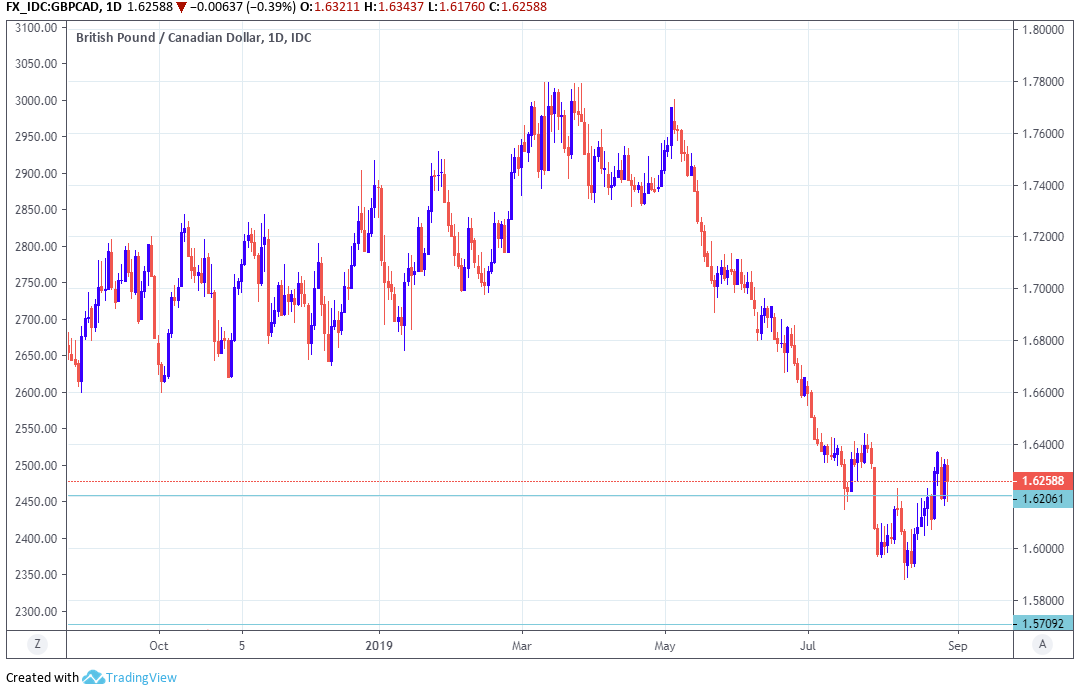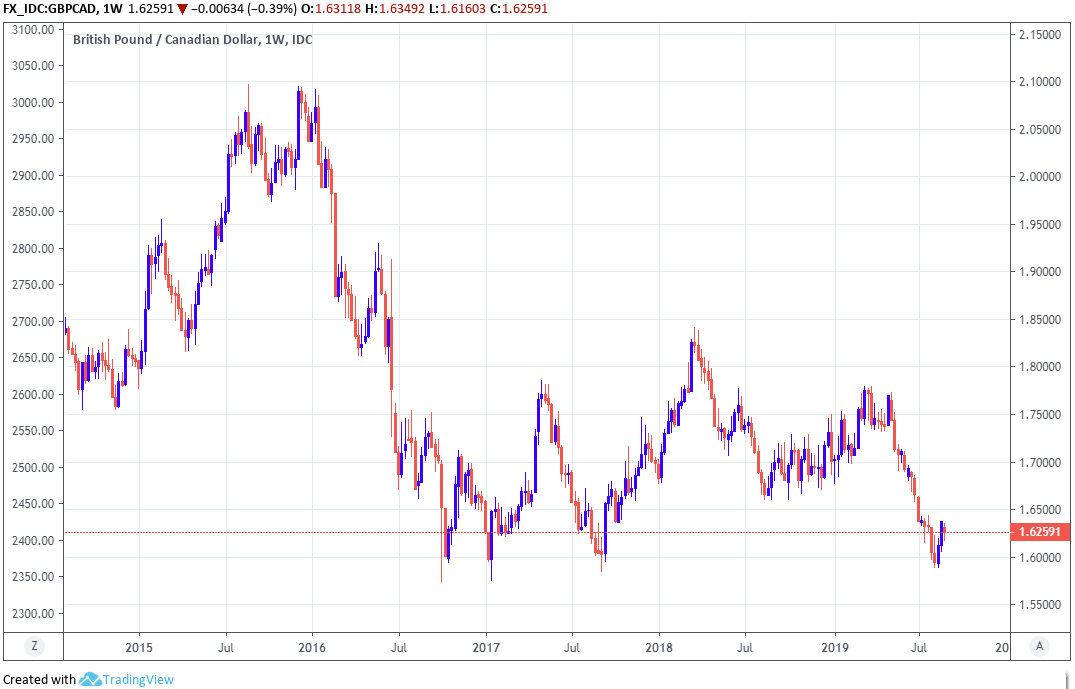Sell the Pound against the Canadian Dollar: Strategist
- Written by: James Skinner
-

Image © Adobe Stock
- GBP/CAD rate at good selling levels says BMO Capital Markets.
- Says GBP/CAD and AUD/CAD vulnerable amid robust oil prices.
- But USD/CAD rate to remain S&P500 stock market story for now.
- Scotiabank also eyes fresh GBP falls following resistance on charts.
The Pound-to-Canadian Dollar exchange rate is tipped for further losses by strategists at one of Canada's leading investment banks, who are eyeing an uptick in oil prices as a reason to expect gains for the Canadian currency.
"While USD/CAD shold continue to be a quasi equity play at least through Friday's release of Q2 Canadian GDP, we think the oil factor should eventually show up on the crosses if the government oil inventory data confirms the API report," says Greg Anderson, head of FX strategy at BMO Capital Markets.
Expectations for higher oil prices come after the American Petroleum Institute (API) reported U.S. oil inventories fell by a substantial 11 million barrels in the week to August 23, a situation which should put upward pressure on prices.
Falling inventories in the U.S. denote increased demand for oil, which is Canada's largest foreign exchange earner, and could mean Canadian producers saw increased sales during the recent week. This and other factors have already drawn other bids for the Loonie.
"This is the sell zone in USDCAD. I am optimistic on oil as the Saudis seem to have put in a bottom in the $50/$52 area. Meanwhile, Canadian rates are getting close to US rates on some parts of the curve (1y1y Canada is higher, than USA, actually) so the argument for the USD as the only yielder is getting less persuasive," says Brent Donnelly, a trader at HSBC. "I like short USDCAD here (1.3312) with a stop at 1.3362...If this is the top, there is a chance to make 250 points on the trade."
Higher oil sales would be good for the Loonie, even though Canadian oil is priced in U.S. Dollars like all other commodities, because exports are a direct addition in the calculation of GDP just like imports are a subtraction.
However, authorities would count changes in the number of barrels moving across the border, known in statistical parlance as volumes, rather than the monetary value of those barrels.
That means oil can add to Canadian GDP even when prices fall just so long as the country sells more barrels as prices fall, which is rare but not unprecedented. The ICE WTI oil futures price is down 0.8% this month and 5.7% in the last three months, but is still up a hefty 22.7% for 2019.
"Yesterday's price movement in USD/CAD was an interesting natural experiment that demonstrated that risk appetite is still a bigger driver than oil prices (for now)," Anderson says. "GBP/CAD appears to be at a good sell level while the technical pattern in AUD/CAD continues to suggest that the pair is a sell."

Above: Pound-to-Canadian-Dollar rate shown at daily intervals.
The Pound-to-Canadian Dollar rate has now fallen 6.5% for 2019, but BMO Capital Markets forecasts suggest the British currency will fall a lot further against the Canadian Loonie into year-end.
BMO is forecasting a USD/CAD rate of 1.32 around year-end which, when combined with a recently-downgraded GBP/USD projection of 1.16, points the Pound-to-Canadian-Dollar rate in the direction of the 1.53 level.
Sterling was trading close to 1.63 against the Canadian Dollar Wednesday, implying something like another 6% of losses will hit the British unit by year-end.
Time to move your money? Get 3-5% more currency than your bank would offer by using the services of foreign exchange specialists at RationalFX. A specialist broker can deliver you an exchange rate closer to the real market rate, thereby saving you substantial quantities of currency. Find out more here.
* Advertisement
BMO is not the only Canadian firm looking for the Loonie to prosper relative to a Brexit-stricken British Pound because analysts at Scotiabank warned of fresh losses on Tuesday.
"There are signs that the rebound is faltering, with the GBP forming a bearish “evening star” reversal around the initial (23.6%) Fib retracement of the 1.78/1.59 move down at 1.6317. Loss of support at 1.6160/65 would be a more significant indication of renewed weakness. Trend oscillators are neutral on the short term studies but residual bear trend strength is strong on the longer term studies. Look to fade GBP gains or renewed softness below 1.6160," says Eric Theoret, a technical analyst at Scotiabank.
Interest in selling the Pound-to-Canadian-Dollar rate has risen since Wednesday morning when Prime Minister Boris Johnson sought to curtail a rebellion among anti-Brexit MPs by attempting to arrange the closure of parliament between early September and the middle of October in what Downing Street says is a legitimate move that has domestic purposes, but which critics claim is an attempt to force through a 'no deal' Brexit.
One consequence of Johnson's move if it goes through is that opposition and anti-Brexit MPs from other parties in parliament, including the governing Conservative Party, will have less time with which they could attempt to pass legislation that prevents the UK from leaving the EU on October 31. Sterling had rallied at the opening of the holiday-shortened UK week amid speculation that those MPs had the numbers to force Johnson into requesting an extension of the Article 50 negotiating period.

Above: Pound-to-Canadian-Dollar rate shown at weekly intervals.
"Whereas before we were arguing that the next 1-2M would see 1) a no confidence motion leading to, 2) new elections and 3) a WTO Brexit, it now looks like the calculus will yield 1) prorogation, 2) a new parliamentary session, 3) a no confidence motion in mid-October, 4) Brexit on October 31 and 5) new elections in November," says Stephen Gallo, the European counterpart of BMO's Anderson.
Some MPs from the governing Conservative Party had been conspiring with the opposition and members of other groups in order to prevent PM Johnson from taking the UK out of the EU without formal arrangements, which would severely damage his hand in negotiations aimed at getting the EU to agree changes to the withdrawal agreement struck with former PM Theresa May. Johnson is seeking those changes while claiming he'll leave without a deal if necessary, which could be economically damaging for not only the UK, but also the struggling Eurozone and ailing German economies.
The EU withdrawal agreement has a long list of serious flaws, according to its critics among both Brexit-supporting and anti-Brexit MPs, but most controversial of which is the so-called Northern Irish 'backstop'. Johnson is aiming at having it removed from the treaty because it could ultimately force lawmakers into choosing between a technical breakup of the UK or allowing all of the country to become trapped in the EU's legislative and regulatory orbit on a potentially indefinite basis without any influence or control over those things.
"The move makes sense to us. On one side, prorogation strengthens the government's negotiating hand with Brussels (though we have serious doubts that Brussels will "blink" anyway). On the other side, prorogation also allows the government to further accelerate its WTO Brexit planning," Gallo says.
Gallo said in February, when the GBP/USD rate was above 1.33 and at its highest for around a year, that he was making a "no deal Brexit by accident" and a fall to 1.21 in GBP/USD his "base case" for this Autumn. With that target having been met, BMO forecasts have since been revised downward. But back in February, most analysts were speculating about a 'soft Brexit' and tipping Sterling to recover much, if not all, of its post-referendum losses.

Time to move your money? Get 3-5% more currency than your bank would offer by using the services of foreign exchange specialists at RationalFX. A specialist broker can deliver you an exchange rate closer to the real market rate, thereby saving you substantial quantities of currency. Find out more here.
* Advertisement









